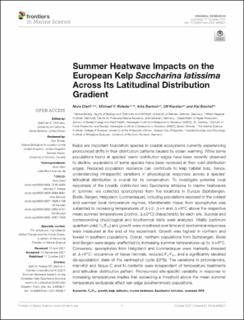| dc.contributor.author | Diehl, Nora | |
| dc.contributor.author | Roleda, Michael | |
| dc.contributor.author | Bartsch, Inka | |
| dc.contributor.author | Karsten, Ulf | |
| dc.contributor.author | Bischof, Kai | |
| dc.date.accessioned | 2021-12-14T14:42:29Z | |
| dc.date.available | 2021-12-14T14:42:29Z | |
| dc.date.created | 2021-11-30T10:31:04Z | |
| dc.date.issued | 2021-10-11 | |
| dc.identifier.citation | Frontiers in Marine Science. 2021, 8 1-14. | en_US |
| dc.identifier.issn | 2296-7745 | |
| dc.identifier.uri | https://hdl.handle.net/11250/2834258 | |
| dc.description.abstract | Kelps are important foundation species in coastal ecosystems currently experiencing pronounced shifts in their distribution patterns caused by ocean warming. While some populations found at species’ warm distribution edges have been recently observed to decline, expansions of some species have been recorded at their cold distribution edges. Reduced population resilience can contribute to kelp habitat loss, hence, understanding intraspecific variations in physiological responses across a species’ latitudinal distribution is crucial for its conservation. To investigate potential local responses of the broadly distributed kelp Saccharina latissima to marine heatwaves in summer, we collected sporophytes from five locations in Europe (Spitsbergen, Bodø, Bergen, Helgoland, Locmariaquer), including populations exposed to the coldest and warmest local temperature regimes. Meristematic tissue from sporophytes was subjected to increasing temperatures of 1+2, 1+4 and 1+6 ◦C above the respective mean summer temperatures (control, 1±0 ◦C) characteristic for each site. Survival and corresponding physiological and biochemical traits were analyzed. Vitality (optimum quantum yield, Fv/Fm) and growth were monitored over time and biochemical responses were measured at the end of the experiment. Growth was highest in northern and lowest in southern populations. Overall, northern populations from Spitsbergen, Bodø and Bergen were largely unaffected by increasing summer temperatures up to 1+6 ◦C. Conversely, sporophytes from Helgoland and Locmariaquer were markedly stressed at 1+6 ◦C: occurrence of tissue necrosis, reduced Fv/Fm, and a significantly elevated de-epoxidation state of the xanthophyll cycle (DPS). The variations in phlorotannins, mannitol and tissue C and N contents were independent of temperature treatments and latitudinal distribution pattern. Pronounced site-specific variability in response to increasing temperatures implies that exceeding a threshold above the mean summer temperature exclusively affect rear-edge (southernmost) populations. | en_US |
| dc.language.iso | eng | en_US |
| dc.publisher | Frontiers Media S.A. | en_US |
| dc.rights | Navngivelse 4.0 Internasjonal | * |
| dc.rights.uri | http://creativecommons.org/licenses/by/4.0/deed.no | * |
| dc.title | Summer Heatwave Impacts on the European Kelp Saccharina latissima Across Its Latitudinal Distribution Gradient | en_US |
| dc.type | Peer reviewed | en_US |
| dc.type | Journal article | en_US |
| dc.description.version | publishedVersion | en_US |
| dc.rights.holder | Copyright © 2021 Diehl, Roleda, Bartsch, Karsten and Bischof | en_US |
| dc.source.pagenumber | 1-14 | en_US |
| dc.source.volume | 8 | en_US |
| dc.source.journal | Frontiers in Marine Science | en_US |
| dc.identifier.doi | 10.3389/fmars.2021.695821 | |
| dc.identifier.cristin | 1961466 | |
| dc.relation.project | EC/H2020/869154 | en_US |
| dc.source.articlenumber | 695821 | en_US |
| cristin.ispublished | true | |
| cristin.fulltext | original | |
| cristin.qualitycode | 1 | |

